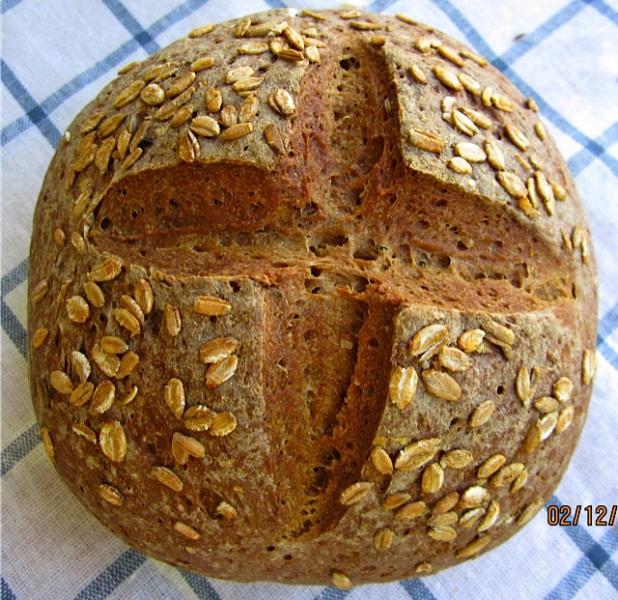
Long time no see - after I baked four breads from my Equal Opportunity Baking list that I wasn't 100% satisfied with, I got a bit burned out on them. The anal Virgo in me didn't want to continue with yet another Fair Baking Bread without having tried to coax and tweak the grade C candidates to a better performance or more satisfying taste.
Slowly I revisited and rebaked (I learned to use the prefix "re" from the creators of our daily crossword puzzle - it is amazing how you can put a "re" in front of any given verb and come up with a new term never heard of before!) the soso breads, Arkatena Bread, Muesli Rolls (both fine now), Camembert Grape Bread, and then the Beer Rye.
I had picked Bill Middeke's contribution to Kim Ode's "Baking with the St. Paul Bread Club" because of the combination stout and rye. In my opinion nothing made with beer can be bad (unless, perhaps, it's made with Bud Light, aka dish wash water, or other beer abominations).
 |
The recipe, originally posted in the "St. Louis Globe-Democrat", had called for lard or bacon fat instead of the shortening listed in Kim Ode's book.
As a German accustomed to cooking with lard, and no friend of shortening, I switched back to the original piggy fat.
For the active dry yeast I used instant, my default, and, also worked with the stretch & fold method, plus overnight cold fermentation, instead of making, and baking, the breads on the same day.
Everything worked well, only the baking time was a bit longer. The bread looked really pretty, but even with the reduced amounts of sugar and molasses it was still way too sweet for my taste!
Bill Middeke, an ardent bicyclist, surely needs sufficient carbohydrates to fuel him for his athletic rides, but my bike carries me mostly to the nearby supermarket, and I get plenty of extra carbs from chocolate and desserts.
Not only that, the best of all husbands complained about the caraway. While I like it, Richard doesn't care for the taste and always finds it overdosed.
So I had another go at the Beer Rye Bread, this time cutting sugar and molasses again by 50%, adding a little more water, to make up for the molasses reduction, and using only 1 teaspoon caraway instead of 1 tablespoon.
We were eager to try the new bread - the sweetness was just right, but with less sugar the bread was a bit bland, and could do with more salt. And my spouse, known to be a delicate little flower, found himself OD'd on caraway again....
Relentlessly adapted to the Andersons' preferences, this final version received the stamp of approval: a tasty bread, slightly sweet, with a hint of caraway, and full of the good stuff: black Ruthless Rye.
 |
| "Ruthless" Rye Bread |
BEER RYE BREAD
(2 small breads)
1 ½ cups stout, or other dark ale (350 g)
70 g water
34 g lard (or shortening)
9 g light brown sugar
21 g molasses
12 g salt
1 tbsp. orange zest, (ca. 8 g)
1/2 tsp. caraway seeds, (or more, to taste)
3 g instant yeast
325 g rye flour
320 g all-purpose flour
rolled rye, for topping
DAY 1:
In saucepan, heat beer and water until just starting to bubble. Add lard, sugar, molasses, salt, orange zest, and caraway seeds. Let cool to lukewarm (not more than 95 F.)
Stir yeast into beer mixture, until dissolved. Pour in mixer bowl, and add flour. Mix at low speed (or by hand) for 1 - 2 minutes, until all flour is hydrated. Let rest for 5 minutes, then knead at medium-low speed (or by hand) for 6 minutes, adjusting with more water or flour, if necessary (dough should be soft and still somewhat sticky.)
Transfer dough to lightly oiled work surface. With oiled hands, stretch and pat into square, first fold top and bottom in thirds, like a business letter, then do the same from both sides.
Gather dough into a ball, place seam side down into a lightly oiled bowl, cover, and let it rest for 10 minutes.
Repeat this stretch and fold 3 times, with 10 minute intervals. After last fold, cover and refrigerate overnight. (I divide the dough at this point in halves, and refrigerate it in two containers.)
DAY 2:
Remove dough from refrigerator 2 hours before using, it should have doubled.
Preheat oven to 425ºF/220ºC, including steam pan.
Shape dough into 2 small boules or bâtards. Place on parchment lined baking sheet, seam side down, and score. Mist or brush with water, sprinkle with rolled rye, cover, and let rise until doubled, ca. 60 minutes or longer (finger poke test, an indentation should not fill up again - if this soft bread is under-proofed, it bursts open in the oven)
Bake breads at 350ºF/180ºC for 20 minutes, steaming with 1 cup boiling water. Rotate breads 180 degrees, remove steam pan, and continue baking for another 20 - 25 minutes, until deep golden brown and registers at least 195ºF/91ºC.)
Cool on wire rack.
 |
| Whether oval or round - Beer Rye Breads are very attractive |

















































